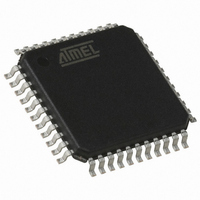AT89C51IC2-RLTIL Atmel, AT89C51IC2-RLTIL Datasheet - Page 89

AT89C51IC2-RLTIL
Manufacturer Part Number
AT89C51IC2-RLTIL
Description
IC 8051 MCU FLASH 32K 44VQFP
Manufacturer
Atmel
Series
89Cr
Datasheet
1.AT89C51IC2-SLRIM.pdf
(147 pages)
Specifications of AT89C51IC2-RLTIL
Core Processor
8051
Core Size
8-Bit
Speed
40MHz
Connectivity
I²C, SPI, UART/USART
Peripherals
POR, PWM, WDT
Number Of I /o
34
Program Memory Size
32KB (32K x 8)
Program Memory Type
FLASH
Ram Size
1.25K x 8
Voltage - Supply (vcc/vdd)
2.7 V ~ 3.6 V
Oscillator Type
External
Operating Temperature
-40°C ~ 85°C
Package / Case
44-TQFP, 44-VQFP
Lead Free Status / RoHS Status
Contains lead / RoHS non-compliant
Eeprom Size
-
Data Converters
-
Available stocks
Company
Part Number
Manufacturer
Quantity
Price
Company:
Part Number:
AT89C51IC2-RLTIL
Manufacturer:
ATMEL
Quantity:
640
Company:
Part Number:
AT89C51IC2-RLTIL
Manufacturer:
ATMEL
Quantity:
4 116
Miscellaneous States
Notes
4301D–8051–02/08
CR2
0
0
0
0
1
1
1
1
slave address followed by the data direction bit which must be at logic 1 (R) for SSLC to
operate in the slave transmitter mode. After its own slave address and the R bit have
been received, the serial interrupt flag is set and a valid status code can be read from
SSCS. This status code is used to vector to an interrupt service routine. The appropriate
action to be taken for each of these status code is detailed in Table 71. The slave trans-
mitter mode may also be entered if arbitration is lost while SSLC is in the master mode.
If the AA bit is reset during a transfer, SSLC will transmit the last byte of the transfer and
enter state C0h or C8h. SSLC is switched to the not addressed slave mode and will
ignore the master receiver if it continues the transfer. Thus the master receiver receives
all 1’s as serial data. While AA is reset, SSLC does not respond to its own slave
address. However, the 2-wire bus is still monitored and address recognition may be
resume at any time by setting AA. This means that the AA bit may be used to tempo-
rarily isolate SSLC from the 2-wire bus.
There are two SSCS codes that do not correspond to a define SSLC hardware state
(Table 72 ). These codes are discuss hereafter.
Status F8h indicates that no relevant information is available because the serial interrupt
flag is not set yet. This occurs between other states and when SSLC is not involved in a
serial transfer.
Status 00h indicates that a bus error has occurred during an SSLC serial transfer. A bus
error is caused when a START or a STOP condition occurs at an illegal position in the
format frame. Examples of such illegal positions happen during the serial transfer of an
address byte, a data byte, or an acknowledge bit. When a bus error occurs, SI is set. To
recover from a bus error, the STO flag must be set and SI must be cleared. This causes
SSLC to enter the not addressed slave mode and to clear the STO flag (no other bits in
SSCON are affected). The SDA and SCL lines are released and no STOP condition is
transmitted.
SSLC interfaces to the external 2-wire bus via two port pins: SCL (serial clock line) and
SDA (serial data line). To avoid low level asserting on these lines when SSLC is
enabled, the output latches of SDA and SLC must be set to logic 1.
Table 67. Bit frequency configuration
CR1
0
0
1
1
0
0
1
1
CR0
0
1
0
1
0
1
0
1
F
OSCA
0.5 <. < 62.5
= 12 MHz
53.5
62.5
100
200
47
75
Bit Frequency ( kHz)
-
F
OSCA
0.67 <. < 83
133.3
266.6
62.5
71.5
= 16 MHz
100
83
-
(reload value range: 0-254 in mode 2)
96 · (256 - reload valueTimer 1)
F
OSCA
Unused
divided by
256
224
192
160
120
60
89















